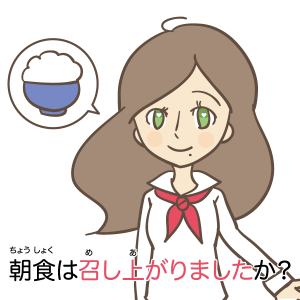You have started a new section: Keigo. This is one of the trickiest topics when learning Japanese. Keigo is a Japanese word and simply means “polite speech,” which consists of the three forms: honorific, humble, and polite. The variety often confuses learners. In everyday life, there will be no problem if you can use the polite form. Thus, if you have no plan to work in Japan, you may skip this section. If you are the person who is willing to work in Japan, you have to master Keigo.
The Usage of the Honorific Form, the Humble Form, and the Polite Form
| Table of Contents Basic Idea of Keigo The Polite Form The Honorific Form The Humble Form |
The reason why Keigo is the trickiest is that you have to memorize the three conjugation rules and use the three forms depending on certain situations. In this lesson, we would like to focus on the basic ideas and the conjugation rules. Regarding the practical usages, you will learn them in the next lesson.
Basic Idea of Keigo
There are three ways to communicate with people in Japanese. As you can see, the chart doesn’t include the polite form. For the sake of simplicity, you may consider the polite form as a kind of tone. No matter which way you choose to communicate, you can speak in polite tone.
The Polite Form
| 田中さんのご自宅に行きました。 [I] went to Tanaka-san’s house. |
| お酒を飲みました。 [I] had alcohol. |
The essential function of the polite form is to show your respect to your listeners by speaking in a polite tone. The polite form has two aspects. The first is to conjugate verbs like 飲む => 飲みます, which you are already familiar with. The second is to attach お or ご to nouns like 酒 => お酒. It is said that お should be attached to words which come from Japanese origin and ご should be attached to words which come from Chinese origin, though there are exceptions. Here are some examples.
| お + Nouns | |||
|---|---|---|---|
| お札: paper money | お休み: day off | お芋: potato | お祝い: celebration |
| お馬: horse | お菓子: pastry | お金: money | お客: guest |
| お給料: salary | お米: rice | お財布: wallet | お魚: fish |
| お酒: alcohol | お皿: dish | お尻: hip | お城: castle |
| ご + Nouns | |||
|---|---|---|---|
| ご機嫌: mood | ご主人: husband | ご祝儀: gratuity | ご縁: fate, destiny |
Annoyingly, you cannot attach お and ご to any noun. There are nouns that are more commonly used with お or ご attached, nouns that you must not attach, and nouns that will become the honorific or the humble form (not the polite form) by attaching ご or お. (*You will learn the two forms in detail later). You need to memorize the usages while exposing yourself to tons of Japanese natural expressions.
| Generally Attach | お母さん, お茶, お箸, ご主人, ご祝儀, etc. |
| Must Not Attach | 携帯電話, インターネット, ごみ箱, 公園, 自転車, etc |
| Change Form | お電話, お鞄, おタバコ, お傘, ご家族, ご研究, etc. |
Supplementary Learning: How to Recognize Which Origin Words Have
Kanji often has two readings. The readings can be categorized into two groups: 音読み (Chinese reading) and 訓読み (Japanese reading). Thus, if the word has a Japanese reading, it has a Japanese origin. Let’s take the kanji 人 as an example. The feature of Japanese reading is that it alone can become a word like “人(ひと): person,” or become a word by combining hiragana. For example, the reading of 主人 is しゅじん. じん cannot become a word alone or by attaching hiragana. Therefore, that’s not a Japanese reading. It means that 主人 has a Chinese origin and you will add ご to make it the polite form, i.e. ご主人. In this way, you can recognize origin by checking whether a reading is a Japanese one or not
人 – Chinese reading: じん, にん | Japanese reading: ひと
[adsense]
The Honorific Form
The function is to show your respects to particular people. It means that you can use this not only to your listeners, but in third person as well. This is one of the big differences from the polite form. Now, let’s check out the conjugation rule.
All Verbs: お + the Polite Form + になる (Instead of ます)
| Plain | Honorific Form | Honorific-Polite Form |
|---|---|---|
| 待つ | お待ちになる | お待ちになります |
| 教える | お教えになる | お教えになります |
Although we have said “All Verbs,” there are a lot of exceptions that you need to follow. We have made a list showing all of the exceptions below. These are very formal expressions. In the author’s opinion, I use this to those who are of high status like government officials.
Exceptions
| Plain | Honorific Form | Honorific-Polite Form |
|---|---|---|
| 行く・来る | いらっしゃる | いらっしゃいます |
| いる | いらっしゃる | いらっしゃいます |
| 食べる・飲む | 召し上がる | 召し上がります |
| 寝る | お休みになる | お休みになります |
| 言う | 仰る | 仰います |
| 見る | ご覧になる | ご覧になります |
| 着る | お召しになる | お召しになります |
| する | なさる | なさいます |
| 知っている | ご存じだ | ご存じです |
| くれる | くださる | くださいます |
Some of verbs which end with る conjugate by using い instead of り. Although both of them are used in everyday life, the ones with い are more commonly used today.
Alternative Form: To Use the Passive Form
| Plain | Honorific Form | Passive Form |
|---|---|---|
| 待つ | 待たれる | 待たれる |
| 泊まる | 泊まられる | 泊まられる |
| する | される | される |
| 来る | 来られる | 来られる |
The alternative form is exactly the same as the passive form. When using the passive form as a honorific form, there are no exceptions. Since the potential form of ru-verbs are also the same, you cannot apply the potential form here to avoid confusion. You need to use the first form, i.e. 待つ => お待ちになる => お待ちになれる. This honorific (passive) form is more frequently used than the first form because it sounds a little less formal.
Adding お and ご to Nouns and Adjectives
| お + Nouns | |||
|---|---|---|---|
| お時間: time | お電話: phone call | お名前: name | お仕事: job |
| お部屋: room | お食事: meal | お手紙: letter | お身体: body |
| お + Adjectives | |||
|---|---|---|---|
| お元気: fine, healthy | お暇: spare time | お好き: to like | お嫌い: to dislike |
| お早い: early, quick | お忙しい: busy | お寂しい: lonely | お高い: high |
| ご + Nouns | |||
|---|---|---|---|
| ご住所: address | ご両親: parents | ご兄弟: brother | ご家族: family |
| ご研究: study | ご意見: opinion | ご関心: interest | ご経験: experience |
| ご + Adjectives | |||
|---|---|---|---|
| ご多忙: busy | ご心配: worried | ご満足: satisfied | ご立派: splendid |
| ご無理: unreasonable | ご熱心: eager | ご自由: free | ご丁寧: polite |
Don’t be confused with the polite form like お酒. The above words have become the honorific form. When you are talking with your close friend, you can still use the polite form like “子供は元気ですか (Is your kid fine)?” That just sound polite. However, it sounds strange if you use the honorific form like “子供はお元気ですか?” because it indicates that you show your respect to the friend’s kid.
Honorific-Request Form: To Replace になる with ください
お待ちください。
お教えください。
ご覧になってください。
仰ってください。
In general, you utilize the first sentence pattern: お + the polite form + になる here. By replacing になる with ください, you can make a request with Keigo. As for the exceptions (Ex. 3 and 4), you utilize the te-form and attach ください.
お待ち(くださる / くださいますか / くださいませんか)?
お教え(くださる / くださいますか / くださいませんか)?
ご覧になって(くださる / くださいますか / くださいませんか)?
仰って(くださる / くださいますか / くださいませんか)?
As you learned before, ください indicates a direct request. If you would like to ask indirectly, you can use interrogative sentences. Keep in mind that they are too formal. In practice, the humble form of もらう is more commonly used when making a formal request like “待っていただけますか?” Now, let’s move to the topic of the humble form.
The Humble Form
The function is to show your respect to recipients of your actions by humbling yourself. Be careful; the targets that you show your respect to are different from the polite form (listeners) and the honorific form (particular people).
All Verbs: お or ご + the Polite Form + する (Instead of (し)ます)
| Plain | Humble Form | Humble-Polite Form |
|---|---|---|
| 待つ | お待ちする | お待ちします |
| 教える | お教えする | お教えします |
| 案内する | ご案内する | ご案内します |
| 連絡する | ご連絡する | ご連絡します |
Be careful; as for suru-verbs, you differently conjugate them, i.e. just attach お or ご. As you learned, お should be attached to words which have a Japanese origin and ご should be attached to words which have a Chinese origin. When you use the humble form, there should be a recipient of your actions. Thus, you cannot use the humble form in the following sentences.
| 明日、海を [I] will swim in the sea tomorrow. |
| 公園を [I] walked in the park. |
There are also a lot of exceptions. For the sake of simplicity, we will show you them along with the ones for the honorific form.
Exceptions of the Humble Form
| Plain | Honorific Form | Humble Form |
|---|---|---|
| 行く・来る | いらっしゃる | 伺う*¹ 参る*º |
| いる | いらっしゃる | おる*² |
| 食べる・飲む | 召し上がる | いただく*º |
| 寝る | お休みになる | – |
| 言う | 仰る | 申す*º 申し上げる*¹ |
| 見る | ご覧になる | 拝見する*¹ |
| 着る | お召しになる | – |
| する | なさる | いたす*º |
| 知っている | ご存じだ | 存じている*º |
| くれる | くださる | – |
| あげる | – | 差し上げる*¹ |
| もらう | – | いただく*¹ |
- Note:
- *º Can be used both with and without a recipient.
- *¹ Can be used only when there is a recipient.
- *² Can be used only when there is NOT a recipient.
The basic idea is that the humble form has to have a recipient of your actions. However, depending on verbs in the exceptions, you can use it without a recipient. Then, if the humble form shows your request to a recipient of your actions, what does it mean when used without a recipient? We call such expressions “Extra Modesty.” Let’s take 行く as an example.
| 田中さんの家に伺いました。 [I] went to Tanaka-san’s house. (*Respect to Tanaka-san) |
| 公園に参りました。 [I] went to the park. (*Respect to your listener) |
Suppose that you are talking with your teacher about what you did yesterday. Then, if you use the first example (the humble form with a recipient), you show your respect to Tanaka-san. By contrast, if you use the second example (the humble form without a recipient), you show your respect to your teacher. By using just the polite form, you can enough express your respect to your listener; however, if you’d like to express your extra modesty, the humble form can be utilized without a recipient. For reference, this expression is often used by TV reporters.
お or ご + Nouns Which Indicate Actions
| お電話: phone call | お話: speech, story | お食事: meal | ご案内: guidance |
| ご回答: answer | ご連絡: contact | ご確認: confirmation | ご挨拶: greeting |
Some nouns alone indicate actions. If you attach お or ご to such nouns, you can use them as a humble form, e.g. “大事なお話があります。(I have something important that I need to talk with you)”.
Summary
- The polite form shows your respect to your listeners.
- The honorific form shows your respect to particular people.
- The humble form shows your respect to recipient of your actions.
- Some of the humble verbs can work without recipients.
Again, you don’t have to memorize the honorific form and the humble form unless you work in Japan. The polite form allows you to communicate to Japanese people without causing any trouble. Even if you work in Japan, you don’t have to be a perfectionist. A lot of native speakers cannot use Keigo in the proper way. In this lesson, we have explained only the basic idea with the conjugation rule. Next, you will learn the practical usage.

Japanese Lessons: Learn Japanese from Manga 2-9-1

How Keigo (Polite Speech) Works in Conversation




